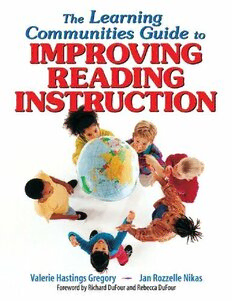Table Of Contentbutuh lengkap hub
sharmilacantiqa@gmail.com
This book is dedicated to our husbands, Arlen Gregory and Peter Nikas, who
have supported our passion for reading, writing, and leading. This book also
is dedicated to the thousands of leaders and teachers who are committed to
creating professional learning communities where teaching and learning for
literacy thrive.
Copyright © 2005 by Corwin Press.
First Skyhorse Publishing edition 2017
All rights reserved. No part of this book may be reproduced in any manner without the
express written consent of the publisher, except in the case of brief excerpts in critical
reviews or articles. All inquiries should be addressed to Skyhorse Publishing, 307 West
36th Street, 11th Floor, New York, NY 10018.
Skyhorse Publishing books may be purchased in bulk at special discounts for sales
promotion, corporate gifts, fund-raising, or educational purposes. Special editions can also
be created to specifications. For details, contact the Special Sales Department, Sky Pony
Press, 307 West 36th Street, 11th Floor, New York, NY 10018 or
info@skyhorsepublishing.com.
Skyhorse® and Skyhorse Publishing® are registered trademark of Skyhorse Publishing,
Inc.®, a Delaware corporation.
Visit our website at www.skyhorsepublishing.com.
10 9 8 7 6 5 4 3 2 1
Library of Congress Cataloging-in-Publication Data is available on file.
Cover design by Michael Dubowe
Print ISBN: 978-1-63450-781-3
Ebook ISBN: 978-1-63450-792-9
Printed in the United States of America
CONTENTS
Foreword
Preface
About the Authors
1. Considering How to Lead Schoolwide Improvement in Reading
Constructive Reflections
2. Personalizing Reading Instruction
What Should We Consider When Planning to Differentiate Literacy
Instruction?
How Can We Get to Know Students’ Interests?
What Is the Link Between Student Motivation, Attitude, Efficacy, and
Reading Materials?
How Can We Match Students to Text?
How Can We Use Assessments to Personalize Reading Instruction?
What Are Some Additional Ways to Personalize Reading Instruction?
What Were the Big Ideas in This Chapter?
Constructive Reflection
3. Managing Environments for Literacy
What Do Students Need from a Literacy Learning Environment?
What Types of Texts Support Rich Literacy Environments?
How Do We Group Students for Reading and Writing at High Levels?
How Is Time Used to Promote High Levels of Reading and Writing?
What Routines Can Be Established for Independent and Small Group
Work?
How Is Classroom Space Organized to Promote High Levels of Reading
and Writing?
What Were the Big Ideas in This Chapter?
Constructive Reflection
4. Ensuring Student Engagement
Why Are Time, Text, Talk, and Task Important to Ensuring Student
Engagement?
What Characterizes Student Engagement?
What Instructional Frameworks Promote Engagement?
What Can We Do to Promote Higher Level Thinking and Talk About
Text?
How Can We Engage Students in Writing and Thinking About Their
Reading?
What Were the Big Ideas in This Chapter?
Constructive Reflection
5. Emphasizing Active Teaching
What Characterizes Exemplary Classrooms?
How Can We Increase Learner-Scaffolded Versus Teacher-Controlled
Instruction?
How Can We Organize Literacy Instruction that Reflects the Teaching-
Learning Zone?
What Should Collaborative Teams Consider in Planning Effective
Instruction?
What Were the Big Ideas in This Chapter?
Constructive Reflection
6. Targeting Comprehension
How Are the Dimensions of Reading Linked?
What Is the Reading Process and What Are Implications for Instruction?
Why Should Reading Instruction Focus on Comprehension and
Vocabulary?
What Is the Difference Between Skills and Strategies Instruction?
What Comprehension Strategies Do Good Readers Use and How Can
We Teach These Strategies?
How Can We Teach Vocabulary to Improve Comprehension?
What Were the Big Ideas in This Chapter?
Constructive Reflections
7. Creating Professional Learning Communities for Literacy
What Are Professional Learning Communities for Literacy?
Why Should We Collect Data About Current Literacy Practices?
What Should We Look for When Examining Current Literacy Practices?
How Can the Reading Reflection Survey Be Introduced to Teachers?
How Is the Survey Used in Classroom Observations and for Self-
Reflection?
How Are the Data Summarized?
How Can the Survey Results Be Used to Plan Professional
Development?
How Do We Create a Supportive Environment for School and
Classroom Change?
What Types of School-Based Professional Development Work?
What Were the Big Ideas in This Chapter?
Constructive Reflection
References
Index
FOREWORD
With the enactment of the educational reform legislation titled No Child
Left Behind (NCLB), the United States has, in effect, boldly
proclaimed that all children will learn—or else. The motivation behind
NCLB legislation has been widely debated. Proponents portray the initiative
as a sincere attempt to guarantee that every child, particularly poor and
minority students, receive an education that leads to high levels of learning.
Opponents contend the legislation is unrealistic and simplistic at best or a
thinly veiled attempt to dismantle the public system of education at worst.
Regardless of the motivation, contemporary public schools in the United
States are being called upon to achieve a standard that goes far beyond the
goals of any previous generation—high levels of learning for all students.
Furthermore, NCLB threatens schools and the educators within them with
escalating sanctions if they fail to meet newly imposed standards. The
rationale behind this approach suggests that educators have always known
how to help all kids learn but have been too disinterested in the welfare of
their students or too lazy to put forth the necessary effort. Fear is needed to
provide the necessary motivation—either perform or risk closing your school
and/or losing your job.
In The Learning Communities Guide to Improving Reading Instruction,
Valerie Gregory and Jan Rozzelle Nikas embrace the premise that schools
and the educators within them must be committed to the learning of each
child entrusted to them. They make a compelling argument that helping each
student develop the ability to read with high levels of comprehension is an
absolute prerequisite if the concept of “learning for all” is to move from
politically correct hyperbole to reality in our nation’s schools. They make it
clear, however, that they honor teachers and teaching, that they believe
educators have the best interests of their students at heart, and most
importantly, that training and support are more effective than threats in

